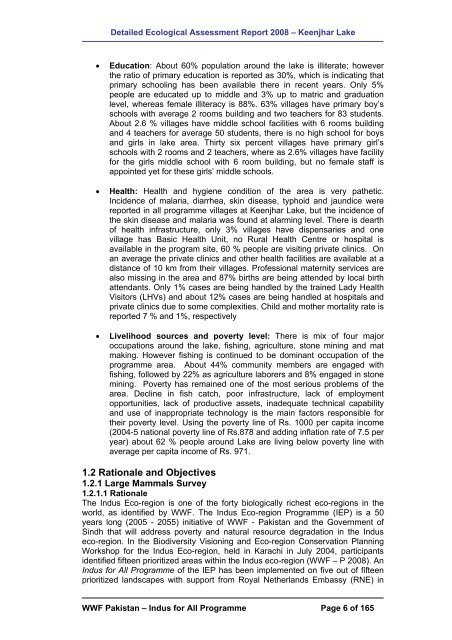Untitled - WWF - Pakistan
Untitled - WWF - Pakistan
Untitled - WWF - Pakistan
Create successful ePaper yourself
Turn your PDF publications into a flip-book with our unique Google optimized e-Paper software.
Detailed Ecological Assessment Report 2008 – Keenjhar Lake<br />
• Education: About 60% population around the lake is illiterate; however<br />
the ratio of primary education is reported as 30%, which is indicating that<br />
primary schooling has been available there in recent years. Only 5%<br />
people are educated up to middle and 3% up to matric and graduation<br />
level, whereas female illiteracy is 88%. 63% villages have primary boy’s<br />
schools with average 2 rooms building and two teachers for 83 students.<br />
About 2.6 % villages have middle school facilities with 6 rooms building<br />
and 4 teachers for average 50 students, there is no high school for boys<br />
and girls in lake area. Thirty six percent villages have primary girl’s<br />
schools with 2 rooms and 2 teachers, where as 2.6% villages have facility<br />
for the girls middle school with 6 room building, but no female staff is<br />
appointed yet for these girls’ middle schools.<br />
• Health: Health and hygiene condition of the area is very pathetic.<br />
Incidence of malaria, diarrhea, skin disease, typhoid and jaundice were<br />
reported in all programme villages at Keenjhar Lake, but the incidence of<br />
the skin disease and malaria was found at alarming level. There is dearth<br />
of health infrastructure, only 3% villages have dispensaries and one<br />
village has Basic Health Unit, no Rural Health Centre or hospital is<br />
available in the program site, 60 % people are visiting private clinics. On<br />
an average the private clinics and other health facilities are available at a<br />
distance of 10 km from their villages. Professional maternity services are<br />
also missing in the area and 87% births are being attended by local birth<br />
attendants. Only 1% cases are being handled by the trained Lady Health<br />
Visitors (LHVs) and about 12% cases are being handled at hospitals and<br />
private clinics due to some complexities. Child and mother mortality rate is<br />
reported 7 % and 1%, respectively<br />
• Livelihood sources and poverty level: There is mix of four major<br />
occupations around the lake, fishing, agriculture, stone mining and mat<br />
making. However fishing is continued to be dominant occupation of the<br />
programme area. About 44% community members are engaged with<br />
fishing, followed by 22% as agriculture laborers and 8% engaged in stone<br />
mining. Poverty has remained one of the most serious problems of the<br />
area. Decline in fish catch, poor infrastructure, lack of employment<br />
opportunities, lack of productive assets, inadequate technical capability<br />
and use of inappropriate technology is the main factors responsible for<br />
their poverty level. Using the poverty line of Rs. 1000 per capita income<br />
(2004-5 national poverty line of Rs.878 and adding inflation rate of 7.5 per<br />
year) about 62 % people around Lake are living below poverty line with<br />
average per capita income of Rs. 971.<br />
1.2 Rationale and Objectives<br />
1.2.1 Large Mammals Survey<br />
1.2.1.1 Rationale<br />
The Indus Eco-region is one of the forty biologically richest eco-regions in the<br />
world, as identified by <strong>WWF</strong>. The Indus Eco-region Programme (IEP) is a 50<br />
years long (2005 - 2055) initiative of <strong>WWF</strong> - <strong>Pakistan</strong> and the Government of<br />
Sindh that will address poverty and natural resource degradation in the Indus<br />
eco-region. In the Biodiversity Visioning and Eco-region Conservation Planning<br />
Workshop for the Indus Eco-region, held in Karachi in July 2004, participants<br />
identified fifteen prioritized areas within the Indus eco-region (<strong>WWF</strong> – P 2008). An<br />
Indus for All Programme of the IEP has been implemented on five out of fifteen<br />
prioritized landscapes with support from Royal Netherlands Embassy (RNE) in<br />
<strong>WWF</strong> <strong>Pakistan</strong> – Indus for All Programme Page 6 of 165
















